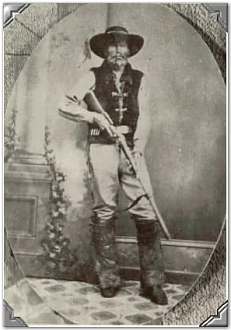Prior to the 1850's, the area that was to become Westminster, Colorado was inhabited by small herds of buffalo and antelope and was dotted with small marshy ponds. There is strong evidence that the Arapaho Indians maintained a semi-permanent encampment in the vicinity of Gregory Hill.
The discovery of gold on Little Dry Creek in 1858 encouraged pioneers to settle in Colorado rather than continue on to the promise of riches in California. The Homestead Act of 1862 also brought many people from the east to settle in the Colorado Territory.
 Jim Baker, for whom Baker Elementary School, Jim Baker Reservoir, and the Baker area are named, has been called the 'Forgotten Mountain Man'. He served the Government as a Scout, Guide and Interpreter. He knew several Indian dialects and was Chief of the Shoshoni for a time. He married Marina in 1846, settled on land near 52nd and Tennyson in 1859, and homesteaded in 1863. He operated a toll ferry and store across Clear Creek, where the old Cherokee Trail crossed the stream, which became known as Baker's Crossing. Jim Baker left our area in 1871 to live in Snake River, Wyoming. There is a stained glass window in the State Capitol to honor him as being the first white man to come this far West and make way for the Pioneers.
Jim Baker, for whom Baker Elementary School, Jim Baker Reservoir, and the Baker area are named, has been called the 'Forgotten Mountain Man'. He served the Government as a Scout, Guide and Interpreter. He knew several Indian dialects and was Chief of the Shoshoni for a time. He married Marina in 1846, settled on land near 52nd and Tennyson in 1859, and homesteaded in 1863. He operated a toll ferry and store across Clear Creek, where the old Cherokee Trail crossed the stream, which became known as Baker's Crossing. Jim Baker left our area in 1871 to live in Snake River, Wyoming. There is a stained glass window in the State Capitol to honor him as being the first white man to come this far West and make way for the Pioneers.
The first permanent settler to build his home in Westminster was Pleasant DeSpain. In 1870, he built his home on 160 acres of farmland near the intersection of 76th Avenue and Lowell Boulevard. He and his five sons planted grain and apple and cherry orchards.
Soon, other settlers began to move into the area then known as DeSpain Junction. Edward Bruce Bowles came West in 1863 driving a herd of cattle across the plains. He homesteaded property in 1871, the year he married Elizabeth Longan. He was a breeder of fine horses and rode in the Denver Pioneer Parade each Colorado Day. The large red brick home is listed on the National Register of Historic Places. The Westminster Historical Society has preserved it as a museum which is open to the public. Please visit the Westminster Historical Society website for Bowles House hours.
The village of DeSpain Junction grew into a small farming community and continued to attract new settlers. The merchants that came to the small village reflected the needs of the farmers and ranchers of the area: blacksmith shop, lumber store, and general store. The railroad came to DeSpain Junction in 1881 and Edward Bowles was instrumental in the construction of the train depot.
Many of the homesteaders found farming in Colorado's arid climate to be much more difficult than they had experienced in the Midwest and the East. For this reason, they sold their land to C.J. Harris, a real estate developer from Connecticut who arrived in DeSpain Junction in 1885. He subdivided the farms he bought into smaller tracts of land which he then sold to fruit farmers. The Harris house can be seen at 7996 Bradburn Blvd. At his request, and with Pleasant DeSpain's permission, the town was renamed Harris, but was also known as Harris Park.